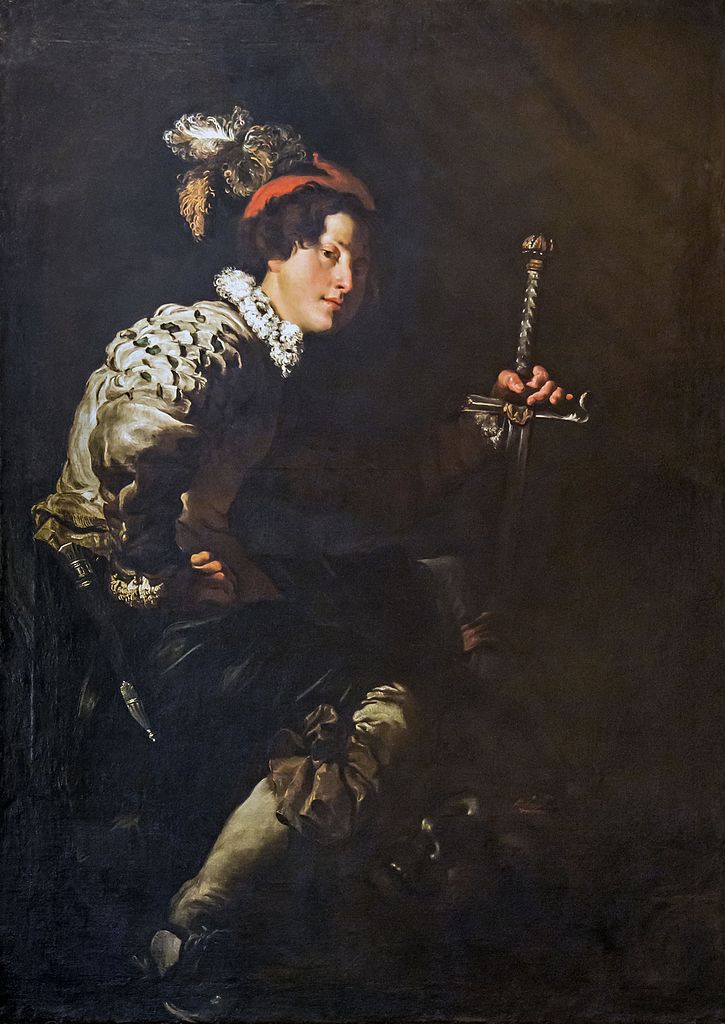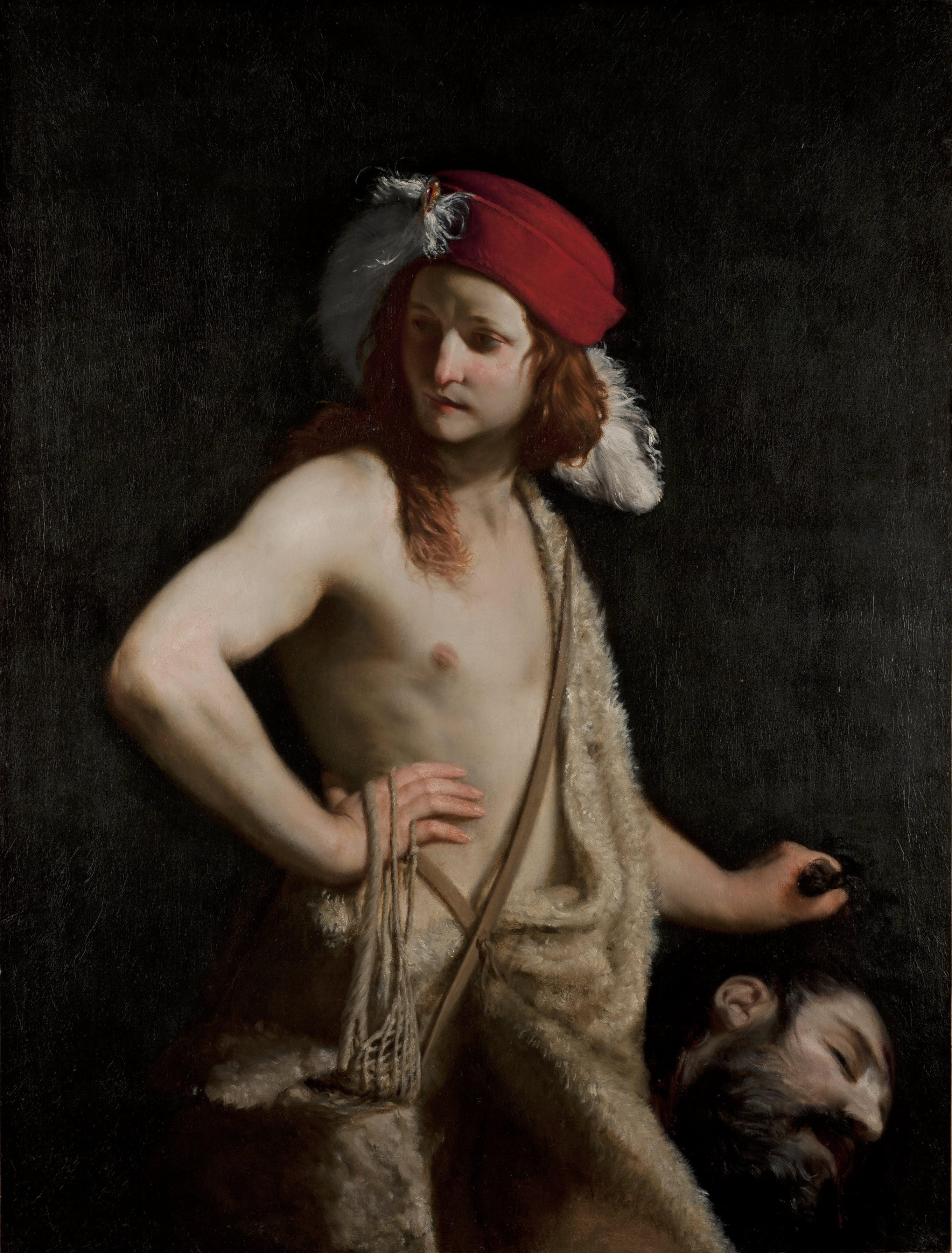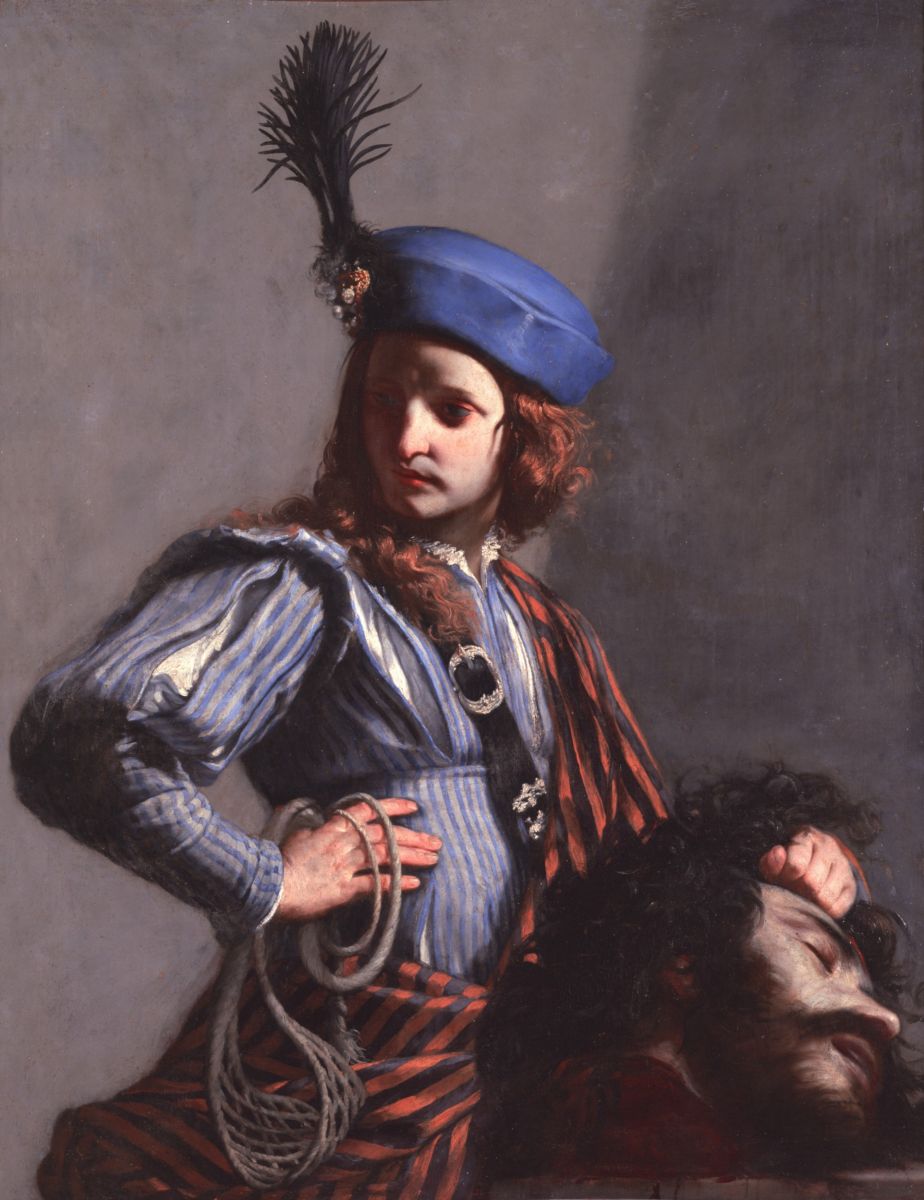The shepherd boy David is one of the Bible’s most prominent and enduringly popular heroes. He later became king of Israel, united the country, and captured Jerusalem. David was also considered the author of many of the Psalms and a direct ancestor of Christ. Guido Cagnacci’s David with the Head of Goliath is based on an episode recounted in 1 Samuel 17:49–54; 18:4, 6–7: In the battle of the Israelites and the Philistines, David volunteered for a one-on-one fight against the Philistines’ leader, Goliath, a giant more than eight feet tall. Having felled the seemingly invincible adversary by slinging a stone that struck the giant on the forehead, he used Goliath’s own sword to decapitate him.
The present painting depicts David after the victory, when he brought the severed head to Jerusalem.1 There he was received by the Israelite women, who sang his praises and favorably compared him with King Saul, thereby arousing the latter’s jealousy. An early copy of the Getty painting adds two women in the background at right, underscoring that the meaning of the composition as the moment of David’s triumphant reception in the city was well understood in the artist’s day.2 With his left hand, David supports Goliath’s head, while the sling he used to slay the giant is seen dangling from his right.
David’s sumptuous attire appears to be at odds with the likely appearance of a shepherd boy who has just returned from a bloody battle. While the large majority of depictions of David with the head of Goliath show him immediately after his victory on the battlefield, Cagnacci instead opted to depict the arrival in Jerusalem, an occasion for which Saul’s son Jonathan had provided David with a change of clothes: “And Jonathan stripped himself of the coat with which he was clothed, and gave it to David, and the rest of his garments” (1 Samuel 18:4).


The fashion for outfitting the protagonists of biblical events in luxurious but anachronistic costumes is something Cagnacci would have admired in the history paintings of Paolo Veronese (1528–1588), whose work he studied with great attention. There were also a few recent precedents for depicting David as a fashionable nobleman: in Domenico Fetti’s David with the Head of Goliath of ca. 1617–19 (fig. 1), in the Contarini collection in Venice until 1838, the young hero wears a doublet with slashed sleeves over a lace-trimmed shirt.3 A David with the Head of Goliath by Bernardo Strozzi (1635; fig. 2) shows the elegantly attired hero marching toward Jerusalem, sword on shoulder, dragging the enormous head along by its hair.4 The female figures in the background may be the Israelite women welcoming him. Two different depictions by Strozzi of ca. 1635 and ca. 16365 combine a richly plumed hat with more rustic clothing. The same blend appears in another canvas—with the battlefield and an encampment in the background—by Fetti (ca. 1614–15)6 and in Cagnacci’s own later variant of the present painting (ca. 1650–55; fig. 3).7

For his portrayal of David and the unusual selection of this particular moment in the narrative, Cagnacci likely drew inspiration from treatments of the story in so-called dramatic dialogues, an early form of oratorio featuring paraphrases of Scripture passages set to music and sung with distributed roles.8 A French visitor described the impact of such a performance he attended in Rome in 1639: “The voices then sang a story from the Old Testament in the form of a spiritual play, such as that of Susanna, Judith and Holofernes, or David and Goliath. Each singer represented a character of the story and expressed the force of the words perfectly. . . . I could not praise enough this recitative music; one must have heard it on the spot to properly judge its merits.”9 It is likely that the “David and Goliath” described here was Stabat adversus Israel Philisteus by Giacomo Carissimi (1605–1674), the most important composer in mid-seventeenth-century Rome. Carissimi’s composition was first performed in 1639 and, with a length of about thirteen minutes, would have shared a program with other pieces on biblical themes.10 The final lines of the libretto describe the hero’s reception in Jerusalem: “But when David returned, having slain the Philistine, the daughters of Zion came to him, joyfully singing, dancing, and playing their tambourines, and praising him by saying: ‘Saul has slain a thousand, and David ten thousand, and he took away the disgrace from Israel.’”11

Cagnacci’s peripatetic existence during much of the 1630s and 1640s makes it difficult to pinpoint where and when he may have encountered a performance of a certain composition. Like the painter, the musical scores traveled around Italy, and like his works, they were often copied and reproduced. Another dramatic dialogue on the subject of David’s victory, Mentre su l’alto monte, also known as the Dialogo di David, was created in 1619 by Giovanni Francesco Anerio (ca. 1567–1630) as part of the Teatro armonico spirituale di madrigali.12 Its printed score, published the same year, continued to be offered by Italian booksellers into the second half of the seventeenth century.13 The Congregation of the Oratory, which had commissioned the fifteen-minute work for use during the spiritual exercises in their Roman churches, San Girolamo della Carità and the Chiesa Nuova, quickly distributed the printed score to other locations, such as the Oratory in Bologna, where it is recorded in 1620;14 Cagnacci lived in Bologna from 1618 until 1621.
In Mentre su l’alto monte, David sings a solo upon his arrival in Jerusalem: “Behold the savage head, o lovely daughters of Jerusalem, and the exalted miracles of the great God of the living . . . ,” followed by a choir of Hebrews praising his deeds in a paraphrase of 1 Samuel 18:7.15 Cagnacci’s visual representation of the same moment turns the viewer into a member of the fawning multitude greeting David, watching him just as his realization that the adulation shall exact a heavy price in the future is beginning to set in. Cagnacci’s acute psychological insight captures the instant of David’s self-recognition and premonition, as the consequences of his new stature as a military hero, his future as the leader of the Israelites, and the specter of Saul’s jealousy are dawning on him. The boy is about to become an adult.
Cagnacci frequently executed multiple versions of his successful compositions with slight variations. The present painting, dating to ca. 1645–50, is the earliest of the three known autograph versions of David with the Head of Goliath.16 A version in a private collection, painted around 1655, shows David in a costume of striped fabric instead of solid blue and has a more pronounced chiaroscuro, plunging part of David’s face into a deep shadow that makes it difficult to read his expression (fig. 4).17 The largest of the three versions, now in the Columbia Museum of Art, Columbia, S.C., in South Carolina and datable to ca. 1650–55, differs from the other two in that David is naked to the waist (fig. 3).18
The early provenance of the present painting remains to be clarified. Due to the existence of a number of old copies, it appears likely that the picture was displayed in a prominent collection, where it would have gained popularity and was accessible to copyists.19 While a number of Davids by Cagnacci appear in eighteenth- and nineteenth-century inventories and auction records in Italy, France, and England, these notices—including one intriguing listing of a “David with the Head of Holofernes”20—could refer to any of the three known versions, an additional, lost autograph version, or any of the copies.
- Paintings Department
-
See 1 Samuel 17:54: “And David taking the head of the Philistine brought it to Jerusalem.” ↩︎
-
Oil on canvas, 95 x 75 cm, Finarte, Milan, 15–16 May 1962, lot 54 (sold on 16 May), as Lorenzo Pasinelli. The version now in a private collection was then attributed to Pasinelli; see Guido Cagnacci: Protagonista del Seicento tra Caravaggio e Reni, exh. cat., ed. Daniele Benati and Antonio Paolucci (Milan: Silvana, 2008), pp. 308–9, no. 79. ↩︎
-
See Eduard Safarik, Fetti (Milan: Electa, 1990), p. 48, cat. no. 9; Domenico Fetti 1588/89–1623, exh. cat., ed. Eduard Safarik (Milan: Electa, 1996), p. 119, no. 20. ↩︎
-
See Luisa Mortari, Bernardo Strozzi (Rome: De Luca, 1995), p. 192, no. 496. ↩︎
-
117 x 98 cm, New York, The Metropolitan Museum of Art; 154 x 119 cm, Cincinnati Art Museum. See Luisa Mortari, Bernardo Strozzi (Rome: De Luca, 1995), pp. 190–92, nos. 490, 494. ↩︎
-
160 x 112 cm, Dresden, Gemäldegalerie. See Eduard Safarik, Fetti (Milan: Electa, 1990), p. 44, no. 7. The J. Paul Getty Museum owns a preparatory drawing for this composition (inv. no. 90.GB.119). ↩︎
-
See Laura Muti and Daniele de Sarno Prignano, Guido Cagnacci: Hypóstasis (Faenza: Edit Faenza, 2009), pp. 422–29, no. 63; Guido Cagnacci: Protagonista del Seicento tra Caravaggio e Reni, exh. cat., ed. Daniele Benati and Antonio Paolucci (Milan: Silvana, 2008 (note 2), pp. 310–11, no. 80. ↩︎
-
See Howard Smither, “The Latin Dramatic Dialogue and the Nascent Oratorio,” Journal of the American Musicological Society, 20 (1967), pp. 403–33, at p. 428: Early seventeenth-century Italian oratorio was typically “a sacred dramatic or narrative-dramatic composition which requires soloists to sing the roles and sometimes join in ensembles, usually includes a narrator’s part, sometimes employs a chorus, and is normally performed without scenery, costumes, or action.” ↩︎
-
André Maugars, Response faite à un curieux sur le sentiment de la musique d’Italie: Escrite à Rome le premier octobre 1639 (Paris: n.p., 1639; reprint ed., Geneva: Minkoff, 1993), pp. 11–12: “Les voix apres chantoient une histoire du vieil Testament, en forme d’une Comedie spirituelle; comme celle de Susanne, de Iudith et d’Holoferne, de David et de Goliat. Chaque Chantre representoit un personnage de l’histoire, et exprimoit parfaitement bien l’energie des paroles. . . . Je ne vous sçaurois loüer assez cette Musique Recitative, il faut l’avoir entenduë sur les lieux pour bien juger de son merite.” ↩︎
-
See Jiří Sehnal and Jitřenka Pešková, Caroli de Liechtenstein-Castelcorno Episcopi Olomucensis operum artis musicae collectio Cremsirii reservata, 2 vols. (Prague: Supraphon, 1997–98), no. 145; Iva Buff, A Thematic Catalog of the Sacred Works of Giacomo Carissimi (Clifton, N.J.: European American Music, 1979), p. 125. The score (Kroměříž, Czech Republic, Archiepiscopal Palace, Music Archive, A 357) will be published in a forthcoming volume of the Edizione critica delle opere complete di Giacomo Carissimi, ed. Daniele Torelli. ↩︎
-
“Cum autem reverteretur David / percusso Philisteo / agressae sunt filiae Sion cantantes / chorosque ducentes in timpanis laetitia, / plaudentes, ludentes et dicentes: / ‘Percussit Saul mille / et David decem millia / et abstulit opprobrium ex Israel.’” ↩︎
-
See Oratorios of the Italian Baroque, vol. 1: Antecedents of the Oratorio. Sacred Dramatic Dialogues, 1600–1630, ed. Howard Smither (Laaber: Laaber-Verlag, 1985), pp. 343–90; Wayne Clanton Hobbs, “Giovanni Francesco Anerio’s Teatro armonico spirituale de madrigali: A Contribution to the Early History of the Oratorio” (PhD diss., Tulane University, 1971). ↩︎
-
Teatro armonico spirituale di madrigali a cinque, sei, sette et otto voci concertati con il basso per l’organo composto dal reverendo D. Gio. Francesco Anerio romano (Rome: Robletti, 1619). ↩︎
-
The printed score of the Teatro armonico appears in music book inventories of 1620 and 1622; see Oscar Mischiati, “Per la storia dell’oratorio a Bologna: Tre inventari del 1620, 1622 e 1682,” Collectanea historiae musicae, 3 (1962–63), pp. 131–70, at pp. 138–39, nos. 1, 9; Victor Crowther, The Oratorio in Bologna, 1650–1730 (Oxford: Oxford University Press, 1999), p. 25, n. 27. ↩︎
-
Oratorios of the Italian Baroque, vol. I: Antecedents of the Oratorio. Sacred Dramatic Dialogues, 1600–1630, ed. Howard Smither (Laaber: Laaber-Verlag, 1985), p. 365, bars 202–13: “Mirate il capo fiero, mirate il capo fiero, o di Gerusalem’ gradite figlie, e l’alte meraviglie del gran Dio de’ viventi spiegate in vaghe note e lieti accenti!”; pp. 369–70, bars 263–82: “A mille alme le lor’ salme di Saul spogliò la mano. Ma Davide n’ha trafitte dieci mila, dieci mila, dieci mila in questo piano.” ↩︎
-
See Daniele Benati, “Guido Cagnacci: Il corpo e l’anima,” in Guido Cagnacci: Protagonista del Seicento tra Caravaggio e Reni, exh. cat., ed. Daniele Benati and Antonio Paolucci (Milan: Silvana, 2008), pp. 27–53, at p. 46. ↩︎
-
See Laura Muti and Daniele de Sarno Prignano, Guido Cagnacci: Hypóstasis (Faenza: Edit Faenza, 2009), pp. 376–78, no. 49; Guido Cagnacci: Protagonista del Seicento tra Caravaggio e Reni, exh. cat., ed. Daniele Benati and Antonio Paolucci (Milan: Silvana, 2008), pp. 308–9, no. 79. ↩︎
-
See Laura Muti and Daniele de Sarno Prignano, Guido Cagnacci: Hypóstasis (Faenza: Edit Faenza, 2009), pp. 422–29, no. 63; Guido Cagnacci: Protagonista del Seicento tra Caravaggio e Reni, exh. cat., ed. Daniele Benati and Antonio Paolucci (Milan: Silvana, 2008), pp. 310–11, no. 80. ↩︎
-
Attributed to Girolamo Forabosco, oil on canvas, 106 x 84 cm, Carnelli collection sale, Galleria Lurati, Milan, 15–17 April 1930, lot 135; after Guido Cagnacci, oil on canvas, 108 x 90 cm, Semenzato, Venice, 15 December 2000, lot 145 and Semenzato, Venice, 19 May 2001, lot 1128; after Guido Cagnacci, oil on canvas, 119 x 78 cm, Sotheby’s, Milan, 5 March 2003, lot 224; after Guido Cagnacci, oil on canvas, 107 x 83.5 cm, Bonhams, London, 14 June 2006, lot 114. See also note 2. ↩︎
-
See Marcello Oretti e il patrimonio artistico privato bolognese.: Bologna, Biblioteca Comunale, Ms. B. 104, eds. Emilia Calbi and Daniela Scaglietti Kelescian (Bologna: Istituto per i Beni Artistici, Culturali e Naturali della Regione Emilia-Romagna, 1984), p. 52. ↩︎